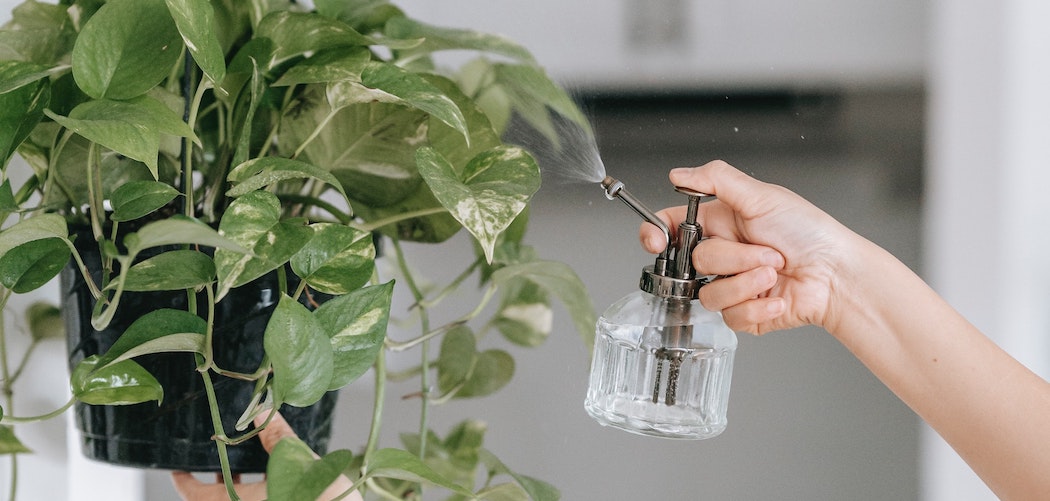Misting houseplants is a major element of a good care routine, but like all aspects of looking after a plant, you need to do it at the right time and in the right way.
When winter comes, your plants will need less water anyway, so will misting do them more harm than good?
In this article, we will finally answer if misting is safe to do in the winter, as well as other important questions.
Firstly, Here’s if You Should Mist Houseplants In Winter:
Yes, it is safe and you should mist houseplants in winter because the humidity of your home can drop to as low as 10-20% in the winter. You’re likely to be running heaters that will dry the air, and winter air is naturally dry, so your houseplants will appreciate a boost in humidity.
Can Misting In Winter Damage Your Indoor Plants?
It is unlikely that misting in the winter will damage your indoor plants. Most houseplants like a humidity level of around 50 percent, and if the winter air inside your home is significantly drier than this, your plants are likely to start struggling.
Some plants may begin to show dryness on their leaves, or develop crispy edges.
Misting could theoretically damage your plants if your home is very warm and you mist them heavily and often. This is because warm, perpetually wet conditions can lead to fungal infections, and this could kill your plant.
However, this is not as common in the winter as it is in the summer.
You can reduce the risk by making sure that you only mist your plants in the morning. The water will gradually evaporate and dry before evening, meaning that the plant is dry overnight.
This makes it hard for fungal infections to take over, and should keep your plant safe.
How Often Should You Mist Your Indoor Plants In The Winter?
As a rule of thumb, in winter you can mist your houseplants a few times a week, allowing them to dry out the rest of the time. The frequency with which you need to mist will depend on the kind of plant that you are caring for and how dry your home is.
If you have a houseplant that likes high levels of humidity and your home is very dry, you might be misting it almost every day.
You may wish to purchase a hygrometer to tell you what the humidity levels around your plant are, so you can mist it when the air gets too dry.
It’s a good idea to research the ideal humidity levels for your plant and determine what its needs are before you start misting it.
Some plants prefer lower humidity levels and won’t need any misting, while others like plenty of humidity.
When Is It Too Cold To Mist Your Plants?
As long as your home is reasonably warm, it should never be too cold for you to mist your plants. Unless the water is likely to freeze, mist isn’t going to hurt the plant, although you should be careful of plants that are tropical and very sensitive to cold.
Keep these in a warm part of your home so that they don’t get too chilled.
For example, I keep Monsteras and other tropical plants in my bathroom over the winter. Bathrooms are often warm rooms, and the steam from the shower will help to keep the plants nicely humidified without any extra work from you.
If you are worried that a plant is so cold that misting will hurt it, you may wish to relocate the plant to a warmer spot anyway.
Mist it with lukewarm water, not cold water, and there shouldn’t be any risk associated with elevating the humidity levels.
However, if the plant is in danger of freezing, don’t mist it.
Should You Water Your Indoor Plants In Winter? (Besides Misting)
Yes, your plants do still need watering in the winter, even if you are misting them, because their roots need to have water available that they can absorb and distribute to the plant’s leaves. Even plants with aerial roots still need water around their subterranean roots if they are to thrive.
However, be aware that your indoor plants will need a lot less water in the winter. There are two reasons for this.
The first is that the water will evaporate from the container much more slowly in lower temperatures than it will in the summer, so your plant’s pot probably won’t dry out very fast.
The second is that your plant’s growth is likely to slow down in the winter, and a plant that is growing slowly does not need as much water as a plant that is growing quickly. If your plant turns dormant, it may barely need to drink anything.
This means that it’s very important to check whether your plant needs a drink before you give it one.
Push the tip of your finger into the top inch of the soil to see whether it has dried out. If it still feels wet, your plant is not likely to need a drink yet.
What’s The Best Time Of Year To Mist Your Indoor Plants?
Typically, the best time of the year to mist your indoor plants is in the winter, because the air is much drier in winter. However, the time of year that your plants most need misting will depend on your climate, so it’s best to use a hygrometer to determine when to mist.
For example, if you experience long, hot, and very dry summers, your plants are much more likely to need misting during the summer.
However, if your summers are humid but your winters are dry, you’ll need to be more vigilant about misting during the winter.
In some parts of the world, you will need to mist your plants throughout the year, but in others, you may only need to mist during the driest seasons.
A hygrometer is a great way to determine whether misting is necessary for your plants at any given time.
Misting VS Humidifier In Winter
Humidifiers are better than misters to increase humidity for your plants, especially in the winter, because they provide a constant level of humidity. They can also raise the humidity in the room without getting the plants wet, which will be beneficial if the air temperature is low.
Misting by hand provides moisture too, but this will be much more unstable moisture.
Your plant will be very wet to start with, and will dry out gradually, rather than staying damp. It will also get directly wet, with moisture clinging to its leaves.
If your plant is sensitive to this, it may be better to use a humidifier.
In general, you can use either a humidifier or hand-misting to keep your plants damp in winter, but the consistency provided by a humidifier may be preferable, especially if you have plants that don’t like their leaves being wet – such as the African violet, which likes humidity but not damp foliage.
Humidifiers are more expensive, but you can always make a DYI humidifier tray for your plants to use alongside sparse misting.
Indoor Plants You Can Mist In Winter
You can mist most indoor plants during the winter, just as you can in summer – they will enjoy the boost in humidity.
Indoor plants that particularly like to be misted in the winter include:
- Peace lilies
- Ferns
- Philodendrons
- Orchids
- Crotons
- Begonias
These plants enjoy high levels of humidity, but they also like to be kept warm, so make sure you don’t place them in a cold room or mist them with cold water. Instead, keep the temperature levels high and mist them as you would at warmer times of the year.
Don’t put the plants on a radiator or heater.
Indoor Plants You Should NEVER Mist In Winter
Some plants do not need the boost in humidity at any time of year, and will not appreciate being misted in the winter any more than they do in the summer.
Here are some indoor plants you should never mist in the winter:
- Succulents (these hate to have water on their leaves and will likely rot if you make them too humid)
- Fiddle leaf figs
- Ponytail plants
- Spider plants
- African violets (these dislike having water on their leaves)
- Cacti
Conclusion
Misting houseplants in the winter is a great idea if your home is dry and you have tropical plants that prefer damp air. You can either mist them by hand or use a humidifier, but make sure your plants aren’t getting so cold that the water will freeze.
Very few houseplants can tolerate low temperatures and most will die if you let them get chilled – whether or not you mist them!

